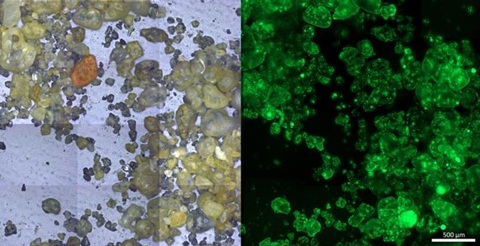Human activities, such as agriculture, have dramatically increased nitrogen inputs into coastal seas. Microorganisms remove much of this human-derived nitrogen in coastal sands through a process called denitrification.

Denitrification generally only occurs in the absence of oxygen. However, observations indicate that it also happens in oxygenated sands, via a thus far unknown mechanism.
READ MORE: Climate change is turning coastal lagoons into ‘salty soup’
READ MORE: Scientists boost denitrification of wastewater with biochar-based substrate
Scientists from the Max Planck Institute for Marine Microbiology in Bremen, Germany, now reveal how this happens: Bunches of microbes, unevenly distributed on the surface of sand grains, use up all the oxygen around them, thus creating anoxic microenvironments in which other microbes can carry out denitrification. The results are now published in the journal Scientific Reports.
Big effects of tiny structures
The scientists used a method called microfluidic imaging, which allowed them to visualize the diverse and uneven distribution of microbes and the oxygen dynamics on extremely small scales.
“Tens of thousands of microorganisms live on a single grain of sand. We were able to distinguish oxygen-consuming and oxygen-producing microbial colonies located within micrometers of each other,” explains Farooq Moin Jalaluddin from the Max Planck Institute for Marine Microbiology.
The scientists could show that some microbes consume more oxygen than is resupplied by the surrounding pore water. Thus, anoxic pockets develop on the surface of the sand grains. These have so far been invisible to conventional techniques. However, their effects are dramatic: “Our estimates based on model simulations show that anaerobic denitrification in these anoxic pockets can account for up to one third of the total denitrification in oxygenated sands,” says Jalaluddin.
Sink of anthropogenic nitrogen
Permeable sands roughly cover half of the continental shelves on our planet, making them a very important habitat in many respects. The Max-Planck-scientists thus also calculated how relevant this newly researched form of nitrogen removal in the tiny anoxic pockets on single sand grains is on a global scale.
“We found that these anoxic microenvironments could account for up to one third of total nitrogen loss in silicate shelf sands,” says co-author Soeren Ahmerkamp, who is now working at the Leibniz Institute for Baltic Sea Research Warnemünde. “Consequently, this denitrification is a substantial sink for anthropogenic nitrogen entering the oceans.”







No comments yet